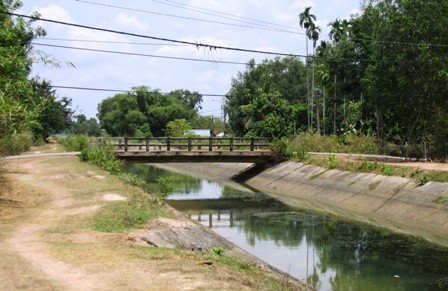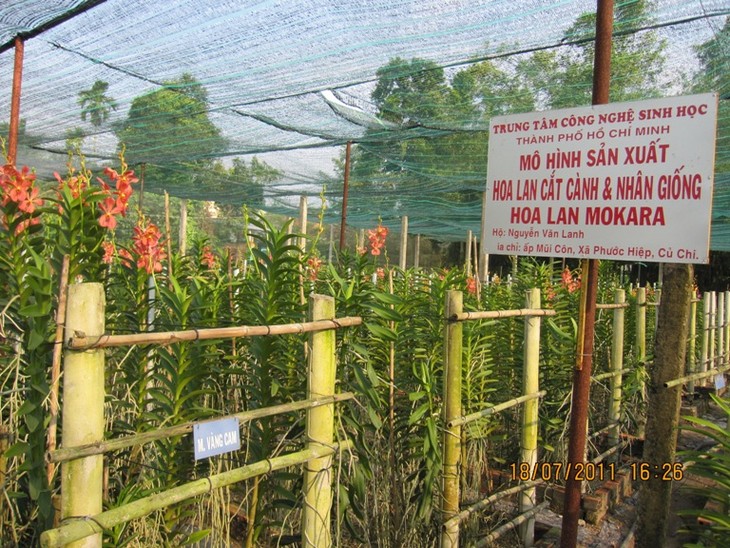(VOVworld) – After 3 years of implementing the new rural development program, Ho Chi Minh city has 2 communes - Tan Thong Hoi and Thai My in Cu Chi district – both achieving all 19 new rural criteria. Cu Chi district, which was a one of the most fierce battlefields in the wars, has become a model for building rural areas on the outskirt of Ho Chi Minh city.

Đông Củ Chi canal waters 12.000 ha of farm land in 12 communes in Củ Chi district. (photo: cuchi.hochiminhcity.gov.vn)
|
Inter-hamlet paved roads in Tan Thong Hoi commune are always crowded with farmers busily loading pots of flowers onto vehicles to transport to market. This year, flower growers in Thong Hoi have enjoyed a surplus because they studied market demand and focused on planting the Mokara orchid. This kind of orchid is low cost to produce, which is suitable for many people. In addition to a profitable crop, their happiness is doubled by the fact that the commune has achieved all new rural criteria levels. Farmer Nguyen Linh says: “Since Tan Thong Hoi commune was chosen to pilot building new rural areas, the villagers were very happy. We thoroughly understood the policy and implemented it jointly. We have upgraded the transportation and irrigation systems and developed production. The farmers are delighted with the program.”
 |
| Model of planting Mokara orchid at the Ho Chi Minh city Biotechnology Center (photo: dost.hochiminhcity.gov.vn) |
Thai My, which was one of the poorest communes in the city, has changed significantly. There have been no muddy roads in the rainy season as in some previous years, as the main roads and inter-hamlet and inner-field lanes have been paved. It’s convenient for farmers to transport crops from the fields to their homes. Before implementing the new rural program, the yearly average income per capita in Thai My was 800 USD. The figure increased by 1.8 times last year. Over 2,400 farmers have been trained to work in industrial, trade, and services sectors. During the program’s implementation, all work was monitored and evaluated with the participation of the people. The farmers have cooperated in deciding the planting schedule and prices of agricultural products. Farmer Tran Thanh Dung lives in My Khanh B hamlet. “Since applying the new rural models, my family’s life has become more stable. I came here in 1982 when the roads were muddy and pupils often fell on the way to school. The roads were tiled and now asphalted which makes it more convenient to travel. The farmers are trained to apply scientific knowledge to the planting of vegetables and rice. They sell products to the cooperatives. The new rural building program is effective.” said Dung.
With a view to mobilizing local resources, the new rural building program has achieved consensus among the community. In 6 communes, 6,300 households donated land for building roads, worth 420 billion Dong. The yearly average income per capita is nearly 26 million Dong, which is 1.6 times higher than before implementing the program. Besides many effective models, there are issues which require compatible measures to obtain better results. Cu Chi district has a high proportion of the agricultural sector, making it difficult for the district to double people’s average income. Tran Van Chi, Chairman of Tan Thong Hoi communal People’s Committee, said: “After 3 years of building new rural areas, we reached all 19 of the new rural criteria which has improved the face of the commune and generated improved conditions for production development. The result can be attributed to the efforts of the administration and people. But some of the achieved criteria are unstable, such as the enhancement of the sport movement. We have to work harder to obtain sustainable results.”
People in Cu Chi are striving to become better off and contribute to their home village. This suburb of Ho Chi Minh city is developing day by day on a par with the city’s growth rate, with a more modern infrastructure and increasingly stable society.
Bich Huyen/ Vinh Phong